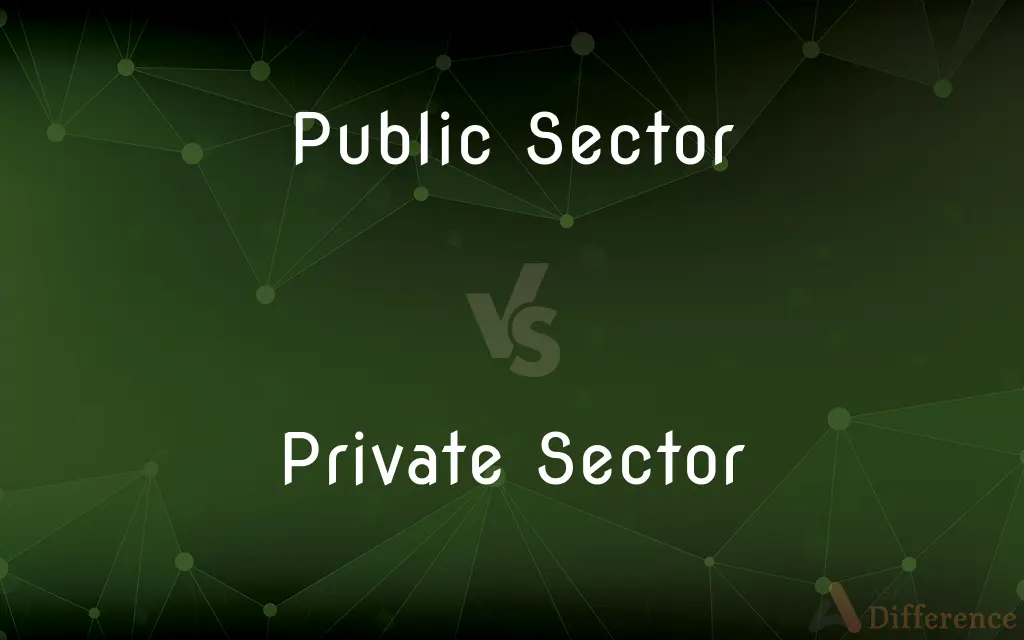Public Sector vs. Private Sector — What's the Difference?
By Tayyaba Rehman & Fiza Rafique — Published on October 31, 2023
Public sector: pertains to government-controlled organizations and services. Private sector: encompasses entities owned and operated by private individuals or corporations.

Difference Between Public Sector and Private Sector
Table of Contents
ADVERTISEMENT
Key Differences
The public sector refers to the part of the economy comprised of state-owned institutions, including national, regional, and local governmental entities. These organizations exist primarily to provide public services and not necessarily to make a profit. On the other hand, the private sector consists of businesses and organizations that are privately owned by individuals, families, or corporations, operating primarily for profit.
The public sector often handles responsibilities and services that benefit the entire community, such as healthcare, education, infrastructure, and public safety. The aim is to ensure that all citizens have equal access to these vital services. The private sector, by contrast, is driven primarily by market demands and seeks to generate revenue. It includes industries like manufacturing, services, and technology.
While the public sector operates under governmental oversight and its decisions are often influenced by political considerations, it aims to ensure the welfare of the general populace. The private sector operates under market forces, and its decisions are influenced by profit motives, competition, and consumer demands.
It's essential to note that the boundary between the public sector and private sector is not always clear-cut. Some entities operate in a hybrid space, known as public-private partnerships. These partnerships can bring together the efficiency of the private sector with the public sector's aim of maximizing societal welfare.
Both the public sector and private sector play vital roles in the economy. While the public sector seeks to provide essential services and ensure that societal needs are met, the private sector drives innovation, job creation, and economic growth.
ADVERTISEMENT
Comparison Chart
Ownership
Owned by government at various levels.
Owned by private individuals or corporations.
Main Objective
Public welfare and service delivery.
Profit generation.
Decision Influences
Political considerations, public needs.
Market forces, competition, profit motives.
Funding
Funded by taxpayers' money.
Funded by private investments or profits.
Examples
Public schools, police departments.
Technology firms, retail businesses.
Compare with Definitions
Public Sector
Organizations aiming for societal benefits.
The public sector plays a role in ensuring public safety.
Private Sector
Organizations operating for profit.
Retail stores in the mall are part of the private sector.
Public Sector
Government-owned and operated entities.
Public schools fall under the public sector.
Private Sector
Corporations outside governmental control.
The private sector largely influences the fashion industry.
Public Sector
Institutions providing services for public welfare.
The public sector ensures everyone has access to basic healthcare.
Private Sector
Entities driven by market demands.
The private sector introduces innovative products to meet consumer needs.
Public Sector
Entities funded by taxpayers' money.
The public sector manages our roadways and infrastructure.
Private Sector
Businesses owned by private individuals or entities.
Tech startups belong to the private sector.
Public Sector
State-controlled organizations and agencies.
Public transportation is a responsibility of the public sector.
Private Sector
Firms seeking revenue generation.
Restaurants operate within the private sector, aiming for profitability.
Private Sector
Of or pertaining to the private sector.
Common Curiosities
Why is the private sector important for an economy?
The private sector drives innovation, economic growth, and job creation.
How does the private sector differ from the public sector?
The private sector includes businesses owned by individuals or corporations, primarily for profit.
Can a company operate in both public sector and private sector spaces?
Yes, through public-private partnerships, entities can operate in both spaces.
Why is the public sector important?
It ensures access to essential services like healthcare, education, and public safety for all citizens.
What comprises the public sector?
The public sector consists of government-owned institutions and services.
Is the public sector always non-profit?
While not aimed at profit-making, some public sector entities generate revenues, but their primary goal is public service.
Are public sector jobs more secure?
Typically, public sector jobs are perceived as more stable than private sector ones, but it can vary.
How does competition differ between the two sectors?
Private sector faces more direct market competition, while public sector competition is often based on service efficiency and quality.
Can the private sector influence the public sector?
Yes, through lobbying, partnerships, and other means, the private sector can influence public sector decisions and policies.
How is success measured in the private sector?
In the private sector, success is often measured by profitability, growth, and market share.
Which sector is bigger in terms of employment?
It varies by country; some have a larger public sector while others have a dominant private sector.
Can a private sector company be turned into a public sector one?
Through nationalization, a government can take control of a private company, making it part of the public sector.
Who funds the public sector?
The public sector is primarily funded by taxpayers' money.
Are public utilities part of the public sector?
While many public utilities are part of the public sector, some are privately owned but regulated by the government.
What drives decisions in the private sector?
Market forces, competition, and profit motives are primary drivers.
Share Your Discovery

Previous Comparison
Share Certificate vs. Share Warrant
Next Comparison
Real Image vs. Virtual ImageAuthor Spotlight
Written by
Tayyaba RehmanTayyaba Rehman is a distinguished writer, currently serving as a primary contributor to askdifference.com. As a researcher in semantics and etymology, Tayyaba's passion for the complexity of languages and their distinctions has found a perfect home on the platform. Tayyaba delves into the intricacies of language, distinguishing between commonly confused words and phrases, thereby providing clarity for readers worldwide.
Co-written by
Fiza RafiqueFiza Rafique is a skilled content writer at AskDifference.com, where she meticulously refines and enhances written pieces. Drawing from her vast editorial expertise, Fiza ensures clarity, accuracy, and precision in every article. Passionate about language, she continually seeks to elevate the quality of content for readers worldwide.
















































